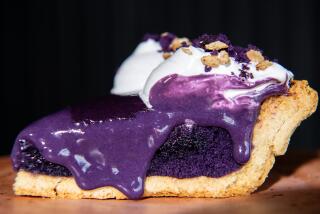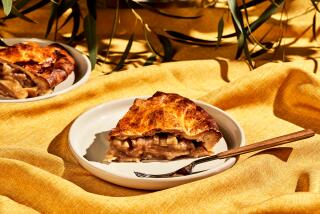Recipe: Nancy Silverton’s apple <i>borsellini</i>
- Share via
Osteria Mozza’s Nancy Silverton is renowned for always trying to find the one perfect way to prepare a dish. So imagine her surprise when she learned she’d been using the wrong dough for her apple borsellini — beggar’s purses filled with baked apples. No matter, she went right to work fixing it, and the result was good enough to be one of our best recipes of the year. The secret is a “rough puff” pastry dough that is easier to prepare than the classic and makes a better wrapper.
Apple borsellini
Total time: 2 hours, 15 minutes, plus macerating and cooling times
Note: From Nancy Silverton of Osteria Mozza
Servings: 12
4 pounds tart apples, such as Granny Smith, peeled, cored and cut into ¾-inch cubes
1 cup granulated sugar
1/4 cup plus 2 tablespoons dark brown sugar
1/4 cup plus 2 tablespoons (¾ stick) butter
2 vanilla beans
2 tablespoons cornstarch
1/4 cup plus 2 tablespoons apple juice
1/2 teaspoon ground cinnamon
1 teaspoon freshly grated nutmeg
Prepared puff pastry, refrigerated
2 egg whites, lightly beaten
1/2 cup cinnamon sugar (½ cup sugar plus 1 teaspoon ground cinnamon)
Powdered sugar, for dusting
1. In a large bowl, toss the apples with the granulated and dark brown sugars. Set aside until the apples start to break down and just begin to release their juices, at least 1 hour and up to overnight.
2. In a medium saucepan heated over high heat, melt the butter. As it is melting, use a small paring knife to split the vanilla bean. Scrape the pulp and seeds out of the bean and add to the melting butter, along with the bean pod. Swirl the pan to ensure the butter cooks evenly and doesn’t burn. Continue cooking until the bubbles subside and the butter is dark brown with a nutty, toasty aroma. Remove from heat and discard the bean pod.
3. Heat the oven to 300 degrees. Cut 12 pieces of kitchen string, each 15 inches long.
4. Toss the apples in the bowl with the cornstarch, apple juice, cinnamon, nutmeg and brown butter. Transfer the filling to a rimmed baking sheet, spreading the apples in a single layer. Roast the apples until they’re tender but keep their shape, 30 minutes, stirring the apples every 10 minutes for even roasting.
5. Transfer the pan to a rack, and cool the filling completely. The filling can be stored, covered and refrigerated, up to 3 days.
6. Remove the puff pastry dough from the refrigerator to a lightly floured surface. Cut the dough into circles using a 4½-inch cutter (a small bowl or cake pan will work). You will need 12 circles; save the scraps for another use (stack the scraps and pat down before using; do not press the dough into a ball, or the layers will be lost).
7. Using a floured rolling pin, roll each circle to a diameter of 7 inches (the circles do not have to be perfect).
8. Scoop one-half cup of the filling and mound it into the center of a circle of dough. Pull up the bottom edges to meet in the center of the filling. Holding the dough with one hand, gather up the edges to meet in the center to pinch it closed like a beggar’s purse. Tie a piece of the kitchen string loosely around the purse, giving it about an inch of slack (the dough will puff as it bakes, so the string should not be tied too tight). Repeat to make the remaining borsellini.
9. Place the borsellini on parchment-lined baking sheets, spacing them about 3 inches apart. Chill the purses at least 30 minutes, up to 3 days before baking.
10. Heat the oven to 400 degrees. Brush the borsellini with egg wash, and sprinkle them liberally with cinnamon sugar.
11. Bake the borsellini until the pastry is puffed and golden brown, 45 minutes to an hour, rotating the baking sheets every 30 minutes.
12. Remove the sheets to a rack to cool. Dust the borsellini with powdered sugar before serving.
Each serving: 706 calories; 5 grams protein; 80 grams carbohydrates; 6 grams fiber; 44 grams fat; 27 grams saturated fat; 114 mg cholesterol; 46 grams sugar; 298 mg sodium.
Rough puff pastry
Total time: 3½ hours, plus overnight chilling time and 3 hours of relaxing time
Servings: Makes a generous 4 ½ pounds of puff pastry
Note: European-style butter (which has a lower water content than most commercial butter) and pastry flour can be found at most well-stocked supermarkets as well as at gourmet markets and cooking stores.
1 1/4 cups (5.3 ounces) all-purpose flour, plus more for dusting
5 1/4 cups (21 ounces) pastry flour
1 tablespoon plus 2 teaspoons kosher salt
9 ounces cold European-style butter, cut into 1- to 1½-inch cubes, plus 1 pound plus 7 ounces cold European-style butter, cut in 1½-inch cubes, divided
3/4 cup plus 2 tablespoons cold water, more if needed
3/4 cup plus 2 tablespoons cold milk
1. In the bowl of a stand mixer, combine the all-purpose and pastry flours with the salt. Using the paddle attachment at low speed, cut in the 9 ounces of cubed butter; the butter will not be completely blended but will be somewhat visible as small chunks. Add the water and milk, and slowly mix it in until the dough just comes together; it will be soft and a bit sticky, but not wet. Add more water if all the flour has not been incorporated. (You can also use a food processor fitted with a metal blade to cut in the butter; turn it out into a bowl and mix in the liquids by hand.)
2. Turn the dough out onto a lightly floured surface and gently knead it a few times until it forms a smooth ball. Use a knife to make a tic-tac-toe cross-hatch in the top of the dough. Place the dough back in the mixer, wrap the bowl tightly in plastic wrap and set aside at room temperature for 30 minutes. The dough can also be refrigerated overnight; bring to room temperature before proceeding.
3. Return the bowl to the stand mixer, add the remaining 1 pound and 7 ounces of butter cubes, and mix with the paddle attachment over low speed until the butter is combined but not incorporated, less than a minute; you will still see distinctive chunks of butter. (The butter can also be added by hand, but the butter should be slightly softened: on a floured surface, knead the butter chunks into the dough just until combined but not incorporated.)
4. Remove the dough from the mixer onto a lightly floured work surface. Dust the dough and rolling pin with flour and pat the dough out to a rectangle. (Check the dough frequently while working and using just enough flour to keep the dough from sticking to the work surface or rolling pin). Use a rolling pin to press 5 to 6 ridges into the dough. Working from the top down, roll the pin gently back and forth within the ridges to flatten them slightly; this ensures that the butter is flattened out evenly inside the dough. When you’ve reached the last ridge, the dough should be more or less flat. Roll the dough into a long rectangle measuring approximately 8 inches by 20 inches, pulling at the edges to keep them squared off.
5. Turn the dough: To make the first “turn,” fold the dough rectangle into thirds, folding the bottom up a third of the way, and then folding the top down over the first two layers so the top edge of the dough meets the bottom edge. Check to make sure all the edges are lined up. Rotate the dough so the open flap of pastry (like the open side of a book) is on your right. Roll the dough out to a 10-by-24-inch rectangle, using the same ridge method as before, squaring off the edges. Repeat with a second turn. Wrap the dough tightly in plastic wrap and refrigerate for at least 1½ hours to relax the dough.
6. Remove the dough and set aside at room temperature until the dough is malleable, about 30 minutes. Turn the dough twice more, same as before. Cover and chill the dough overnight. The puff pastry dough can be refrigerated up to 5 days, or frozen for up to several months, before proceeding with the final turn. (If freezing the dough, place it in the refrigerator overnight to defrost.)
7. Remove the dough from the refrigerator and set aside until malleable, about 30 minutes. Roll out and turn the dough once more, for a total of 5 turns.
8. Roll the dough out to a thickness of one-fourth inch. Place the dough on parchment-lined baking sheets (cut the dough if necessary to fit), cover and refrigerate for at least 1 hour to give the dough time to relax; otherwise, it will bounce back and shrink as it is baked.
Each of 20 (3.6-ounce) servings: 458 calories; 4 grams protein; 29 grams carbohydrates; 4 grams fiber; 38 grams fat; 24 grams saturated fat; 99 mg cholesterol; 1 gram sugar; 290 mg sodium.
More to Read
Eat your way across L.A.
Get our weekly Tasting Notes newsletter for reviews, news and more.
You may occasionally receive promotional content from the Los Angeles Times.










